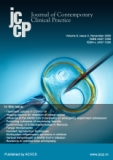Could early obtainable patient data predict outcomes in life-threatening diseases such as necrotising fasciitis? A Turkish single-center experience
Could early obtainable patient data predict outcomes in life-threatening diseases such as necrotising fasciitis? A Turkish single-center experience
Author(s): Gulcin Sahingoz Erdal, Mehmet Hursitoglu, Esra Akdeniz, Sina Ferahman, Deniz Yılmaz, Nursel Kocamaz, Mehmet Emin Gunes, Mehmet Karabulut, Halil Dogan, Hakan Kocoglu, Abdulbaki Kumbasar, Ekrem Guner, Burce Can KuruSubject(s): Higher Education , Health and medicine and law, Present Times (2010 - today)
Published by: Asociația pentru Creșterea Vizibilității Cercetării Științifice (ACVCS)
Keywords: Model; necrotising fasciitis; Fournier’s gangrene; DM; SGLT2 inhibitor; mortality; outcome;
Summary/Abstract: Introduction Necrotising fasciitis (NF) is a rare, life-threatening, infectious condition that requires early diagnosis and treatment. To the best of our knowledge, there is no study in literature that has determined a scoring system and/or predictor(s) of mortality from easily obtainable (non-physicianrelated) NF patient admission data. Objectıves: to determine predictor(s) of the outcome of NF from the above-mentioned early admission patient parameters. It was also aimed to ascertain from real life data whether sodium-glucose co-transporter 2 (SGLT2) inhibitor, a new oral hypoglycemic agent, increases the risk and frequency of NF as has been suggested. Methods A retrospective evaluation was made of the data of a total of 106 patients diagnosed with NF. Early obtainable patient data (age, gender, the presence of diabetes mellitus (DM), laboratory measures, causative pathogens) were recorded and analyzed according to the outcome results (survival or death). Results The mean age of the patients was 58±16 years old. Death occurred in 32 of the 106 patients with NF. Age, the presence of DM, serum creatinine level, blood platelet (PLT) count, and Acinetobacter or Klebsiella spp. as causative pathogens of NF were significantly associated with mortality. Using these parameters, a pilot model to predict mortality was developed. Despite the increased use of SGLT2 inhibitors, no drug-related NF cases were encountered. Conclusions Using the above-mentioned model, the mortality of NF patients can be predicted from simple and obtainable data. Further studies are needed to confirm and validate this pilot model.
Journal: Journal of Contemporary Clinical Practice
- Issue Year: 6/2020
- Issue No: 2
- Page Range: 64-74
- Page Count: 11
- Language: English

